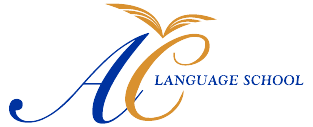- Define artificial intelligence and its applications in diplomacy.
- Analyze the geopolitical implications of AI leadership and regulation.
- Explore global frameworks and efforts for AI governance.
- Evaluate the risks and benefits of AI deployment in foreign affairs.
- Apply ethical principles to AI-related diplomatic decisions.
- Examine the role of AI in cybersecurity and national sovereignty.
- Collaborate across borders to address AI challenges and standards.
- Design diplomatic approaches for AI in conflict prevention and peacebuilding.
- Develop communication strategies for AI-related negotiations.
- Propose a national strategy for AI and international diplomatic engagement.
-
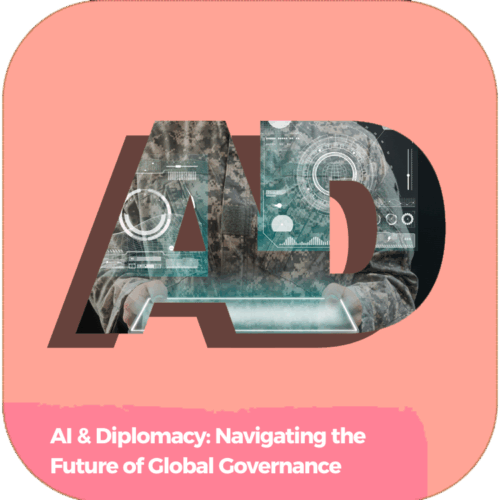 Course Description: This cutting-edge course explores the intersection of artificial intelligence (AI) and international diplomacy. Participants will examine AI’s role in shaping global governance, cybersecurity, digital rights, and foreign policy. Through case studies, simulations, and strategic planning, students will develop informed approaches to AI ethics, regulation, and cross-border cooperation in diplomatic practice. Course Length: 6 weeks (36 total instructional hours) Proficiency Level: Advanced Prerequisite: Completion of a lower-intermediate ESL course or equivalent language proficiency Course Objectives:
Course Description: This cutting-edge course explores the intersection of artificial intelligence (AI) and international diplomacy. Participants will examine AI’s role in shaping global governance, cybersecurity, digital rights, and foreign policy. Through case studies, simulations, and strategic planning, students will develop informed approaches to AI ethics, regulation, and cross-border cooperation in diplomatic practice. Course Length: 6 weeks (36 total instructional hours) Proficiency Level: Advanced Prerequisite: Completion of a lower-intermediate ESL course or equivalent language proficiency Course Objectives: -
 Course Description: This course examines the contrasting and complementary roles of bilateral and multilateral diplomacy in advancing foreign policy goals. Participants will explore institutional dynamics, negotiation strategies, and policy alignment across both formats. Through simulations and comparative analysis, students will learn to navigate complex diplomatic environments and select the most effective channels for representation, influence, and agreement. Course Length: 6 weeks (36 total instructional hours) Proficiency Level: Advanced Prerequisite: Completion of a lower-intermediate ESL course or equivalent language proficiency Course Objectives:
Course Description: This course examines the contrasting and complementary roles of bilateral and multilateral diplomacy in advancing foreign policy goals. Participants will explore institutional dynamics, negotiation strategies, and policy alignment across both formats. Through simulations and comparative analysis, students will learn to navigate complex diplomatic environments and select the most effective channels for representation, influence, and agreement. Course Length: 6 weeks (36 total instructional hours) Proficiency Level: Advanced Prerequisite: Completion of a lower-intermediate ESL course or equivalent language proficiency Course Objectives:- Define bilateral and multilateral diplomacy and their key distinctions.
- Analyze the advantages and limitations of each diplomatic approach.
- Identify institutions central to multilateral diplomacy (UN, WTO, AU, etc.).
- Plan diplomatic engagements based on format appropriateness.
- Design negotiation strategies suited to bilateral or multilateral settings.
- Evaluate case studies in multilateral consensus-building.
- Balance national priorities with collective objectives in multilateral forums.
- Engage in diplomatic simulations requiring cross-format strategy shifts.
- Align policy messaging across diverse international platforms.
- Develop a strategic engagement plan using both bilateral and multilateral tools.
-
 Course Description: This final capstone course brings together the knowledge, skills, and tools developed across the entire diplomacy program. Participants will design a comprehensive diplomatic strategy and present it to a simulated national leadership team. This experience simulates high-level policy advising, cross-ministerial dialogue, and strategic decision-making in complex global scenarios. Course Length: 6 weeks (36 total instructional hours) Proficiency Level: Advanced Prerequisite: Completion of a lower-intermediate ESL course or equivalent language proficiency Course Objectives:
Course Description: This final capstone course brings together the knowledge, skills, and tools developed across the entire diplomacy program. Participants will design a comprehensive diplomatic strategy and present it to a simulated national leadership team. This experience simulates high-level policy advising, cross-ministerial dialogue, and strategic decision-making in complex global scenarios. Course Length: 6 weeks (36 total instructional hours) Proficiency Level: Advanced Prerequisite: Completion of a lower-intermediate ESL course or equivalent language proficiency Course Objectives:- Integrate strategic thinking from across the program into one final project.
- Analyze global challenges and opportunities through a national interest lens.
- Develop a cross-sector diplomatic engagement strategy.
- Draft policy briefings, strategic plans, and diplomatic memos.
- Coordinate interagency and multilateral priorities within one document.
- Present a cohesive argument to a high-level decision-making panel.
- Simulate real-time Q&A and cabinet-style policy interrogation.
- Demonstrate leadership, persuasion, and negotiation under scrutiny.
- Evaluate peer presentations and provide strategic feedback.
- Produce a full strategy document with clear objectives, tactics, and impact metrics.
-
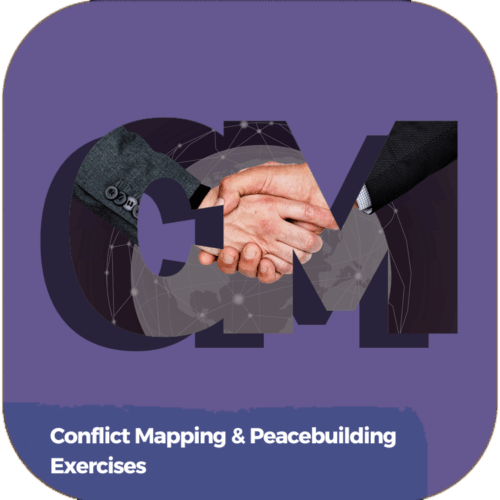 Course Description: This course equips participants with analytical tools and experiential methods to understand, map, and address violent conflict. Students will engage in interactive simulations, stakeholder analysis, and peacebuilding exercises to build skills in mediation, reconciliation, and post-conflict recovery. The course supports diplomats in fostering sustainable peace through systemic understanding and collaborative action. Course Length: 6 weeks (36 total instructional hours) Proficiency Level: Advanced Prerequisite: Completion of a lower-intermediate ESL course or equivalent language proficiency Course Objectives:
Course Description: This course equips participants with analytical tools and experiential methods to understand, map, and address violent conflict. Students will engage in interactive simulations, stakeholder analysis, and peacebuilding exercises to build skills in mediation, reconciliation, and post-conflict recovery. The course supports diplomats in fostering sustainable peace through systemic understanding and collaborative action. Course Length: 6 weeks (36 total instructional hours) Proficiency Level: Advanced Prerequisite: Completion of a lower-intermediate ESL course or equivalent language proficiency Course Objectives:- Define conflict mapping and its role in peacebuilding.
- Analyze root causes, actors, and dynamics of conflict.
- Construct conflict timelines and relationship maps.
- Evaluate peacebuilding models and approaches.
- Practice stakeholder engagement and interest analysis.
- Apply mediation and dialogue techniques in simulations.
- Design inclusive peacebuilding strategies.
- Assess risks and resilience factors for peace processes.
- Utilize visual tools for conflict transformation analysis.
- Develop a conflict-sensitive strategy for diplomatic engagement.
-
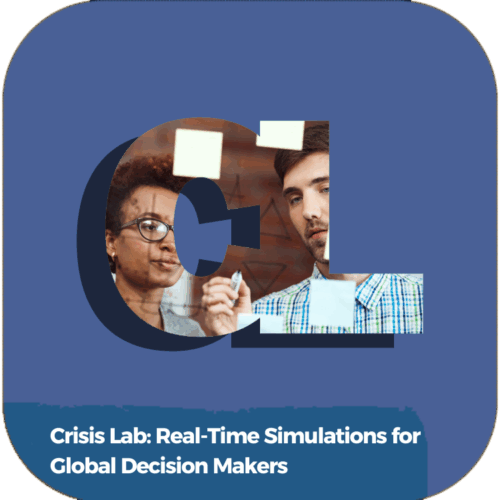 Course Description: This advanced simulation-based course immerses diplomats and global leaders in high-intensity crisis scenarios. Participants will be challenged to make strategic decisions under pressure, manage multi-stakeholder responses, and lead teams during evolving global events. The lab is designed to test diplomatic agility, communication, ethics, and leadership in the face of real-world uncertainty. Course Length: 6 weeks (36 total instructional hours) Proficiency Level: Advanced Prerequisite: Completion of a lower-intermediate ESL course or equivalent language proficiency Course Objectives:
Course Description: This advanced simulation-based course immerses diplomats and global leaders in high-intensity crisis scenarios. Participants will be challenged to make strategic decisions under pressure, manage multi-stakeholder responses, and lead teams during evolving global events. The lab is designed to test diplomatic agility, communication, ethics, and leadership in the face of real-world uncertainty. Course Length: 6 weeks (36 total instructional hours) Proficiency Level: Advanced Prerequisite: Completion of a lower-intermediate ESL course or equivalent language proficiency Course Objectives:- Demonstrate diplomatic leadership during complex global crises.
- Analyze rapidly evolving scenarios with incomplete information.
- Coordinate response strategies across ministries and alliances.
- Negotiate under pressure with limited time and shifting stakes.
- Apply ethical frameworks and values in decision-making.
- Develop clear, effective communication in high-stress environments.
- Respond to misinformation, escalation, and international scrutiny.
- Utilize digital platforms for situational awareness and coordination.
- Reflect on performance and lessons learned from live simulations.
- Design personal protocols for crisis engagement and team resilience.
-
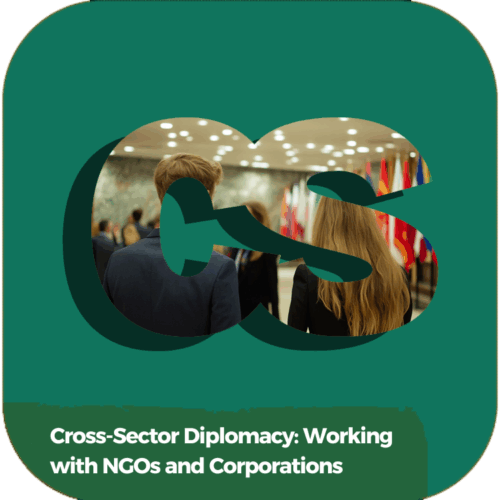 Course Description: This course explores how diplomats collaborate with non-governmental organizations, private corporations, and multilateral partners to solve complex global problems. Participants will learn tools to build public-private partnerships, foster stakeholder trust, and align foreign policy objectives with corporate responsibility and civil society innovation. Course Length: 6 weeks (36 total instructional hours) Proficiency Level: Advanced Prerequisite: Completion of a lower-intermediate ESL course or equivalent language proficiency Course Objectives:
Course Description: This course explores how diplomats collaborate with non-governmental organizations, private corporations, and multilateral partners to solve complex global problems. Participants will learn tools to build public-private partnerships, foster stakeholder trust, and align foreign policy objectives with corporate responsibility and civil society innovation. Course Length: 6 weeks (36 total instructional hours) Proficiency Level: Advanced Prerequisite: Completion of a lower-intermediate ESL course or equivalent language proficiency Course Objectives:- Define cross-sector diplomacy and its relevance in global affairs.
- Analyze stakeholder roles in international partnerships and diplomacy.
- Evaluate models for public-private and multistakeholder collaboration.
- Develop engagement strategies for NGOs and corporate partners.
- Assess corporate social responsibility (CSR) and its alignment with diplomacy.
- Mitigate risks and manage expectations in diverse stakeholder settings.
- Facilitate consensus and cooperation in high-complexity environments.
- Negotiate partnership agreements and diplomatic memoranda of understanding.
- Monitor and evaluate impact across sectors and policy outcomes.
- Design a strategic cross-sector engagement plan for a foreign mission.
-
 Course Description: This course explores how culture is used as a strategic tool in diplomacy to build influence, foster mutual understanding, and advance foreign policy goals. Participants will examine cultural diplomacy initiatives, global branding, soft power theory, and the design of programs that promote national image and cross-cultural dialogue. Course Length: 6 weeks (36 total instructional hours) Proficiency Level: Advanced Prerequisite: Completion of a lower-intermediate ESL course or equivalent language proficiency Course Objectives:
Course Description: This course explores how culture is used as a strategic tool in diplomacy to build influence, foster mutual understanding, and advance foreign policy goals. Participants will examine cultural diplomacy initiatives, global branding, soft power theory, and the design of programs that promote national image and cross-cultural dialogue. Course Length: 6 weeks (36 total instructional hours) Proficiency Level: Advanced Prerequisite: Completion of a lower-intermediate ESL course or equivalent language proficiency Course Objectives:- Define soft power and its role in contemporary diplomacy.
- Analyze the strategic value of cultural exchange and engagement.
- Design programs that promote national values and mutual understanding.
- Evaluate public diplomacy tools such as arts, education, and sports.
- Assess the effectiveness of global cultural diplomacy campaigns.
- Coordinate cultural initiatives with embassies and ministries.
- Align cultural programming with broader diplomatic strategy.
- Measure cultural perception and influence in global affairs.
- Foster inclusive, respectful intercultural dialogue and outreach.
- Develop a national soft power strategy for international engagement.
-
 Course Description: This advanced course immerses participants in the formalities, ceremonies, and power dynamics of global protocol as a cornerstone of diplomatic excellence. Students will explore the nuances of state visits, official correspondence, ceremonial precedence, and the unspoken codes that govern elite diplomacy. Drawing on real-world diplomatic case studies, the course empowers future leaders to navigate high-level environments with confidence, precision, and cultural intelligence—maximizing influence through mastery of protocol and prestige. Course Length: 6 weeks (36 total instructional hours) Proficiency Level: Advanced
Course Description: This advanced course immerses participants in the formalities, ceremonies, and power dynamics of global protocol as a cornerstone of diplomatic excellence. Students will explore the nuances of state visits, official correspondence, ceremonial precedence, and the unspoken codes that govern elite diplomacy. Drawing on real-world diplomatic case studies, the course empowers future leaders to navigate high-level environments with confidence, precision, and cultural intelligence—maximizing influence through mastery of protocol and prestige. Course Length: 6 weeks (36 total instructional hours) Proficiency Level: AdvancedPrerequisite:
Completion of a lower-intermediate ESL course or equivalent language proficiency Course Objectives:- Interpret and apply international protocol standards in diverse diplomatic settings.
- Analyze the role of ceremonial prestige in international relations.
- Demonstrate appropriate diplomatic etiquette across cultures.
- Distinguish between formal and informal protocol in bilateral and multilateral contexts.
- Prepare official diplomatic documents and correspondence in proper protocol format.
- Coordinate high-level diplomatic events and state visits.
- Apply the rules of precedence and rank across governments and international organizations.
- Recognize cultural sensitivities and avoid protocol faux pas.
- Evaluate real-world diplomatic incidents involving protocol successes or failures.
- Design and implement a full diplomatic protocol strategy for a hypothetical foreign mission.
-
 Course Description: This course examines diplomatic errors rooted in cultural misunderstandings and provides tools for prevention, response, and recovery. Using real-world case studies, participants will analyze failures in cross-cultural communication, develop cultural intelligence strategies, and practice corrective diplomacy in simulated scenarios. Course Length: 6 weeks (36 total instructional hours) Proficiency Level: Advanced Prerequisite: Completion of a lower-intermediate ESL course or equivalent language proficiency Course Objectives:
Course Description: This course examines diplomatic errors rooted in cultural misunderstandings and provides tools for prevention, response, and recovery. Using real-world case studies, participants will analyze failures in cross-cultural communication, develop cultural intelligence strategies, and practice corrective diplomacy in simulated scenarios. Course Length: 6 weeks (36 total instructional hours) Proficiency Level: Advanced Prerequisite: Completion of a lower-intermediate ESL course or equivalent language proficiency Course Objectives:- Identify cultural dimensions and how they influence diplomatic behavior.
- Analyze real-world diplomatic missteps and their cultural roots.
- Assess the risks and consequences of cultural insensitivity in diplomacy.
- Use cultural intelligence (CQ) to anticipate and manage cross-cultural challenges.
- Develop recovery strategies and apology protocols after missteps.
- Engage in diplomatic correction through appropriate channels.
- Practice culturally adaptive language and body language.
- Design proactive cultural briefings and preparation guides.
- Simulate recovery and narrative control in diplomatic blunders.
- Produce a cultural risk mitigation plan for an assigned post.
-
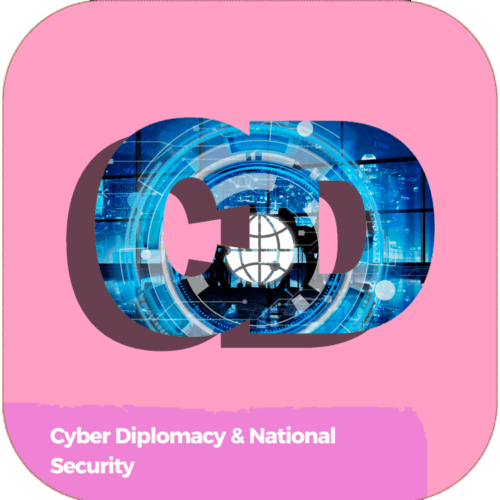 Course Description: This course equips diplomats and national security professionals with the knowledge and tools to engage in cyber diplomacy. It explores cybersecurity threats, global norms for cyberspace, and diplomatic efforts to secure the digital domain. Participants will examine the intersection of cyber policy and international relations, building skills for negotiation, deterrence, coordination, and defense in a rapidly evolving digital landscape. Course Length: 6 weeks (36 total instructional hours) Proficiency Level: Advanced Prerequisite: Completion of a lower-intermediate ESL course or equivalent language proficiency Course Objectives:
Course Description: This course equips diplomats and national security professionals with the knowledge and tools to engage in cyber diplomacy. It explores cybersecurity threats, global norms for cyberspace, and diplomatic efforts to secure the digital domain. Participants will examine the intersection of cyber policy and international relations, building skills for negotiation, deterrence, coordination, and defense in a rapidly evolving digital landscape. Course Length: 6 weeks (36 total instructional hours) Proficiency Level: Advanced Prerequisite: Completion of a lower-intermediate ESL course or equivalent language proficiency Course Objectives:- Define cyber diplomacy and its significance in global security.
- Analyze cyber threats, actors, and national vulnerabilities.
- Interpret international norms and legal frameworks in cyberspace.
- Evaluate confidence-building measures (CBMs) in cyber cooperation.
- Collaborate with intelligence, defense, and civilian sectors.
- Negotiate bilateral and multilateral cyber defense agreements.
- Assess the role of attribution, deterrence, and response in cyber policy.
- Design crisis communication strategies for cyber incidents.
- Engage in cyber simulations and real-time diplomatic responses.
- Develop a cyber diplomacy policy for national security objectives.
